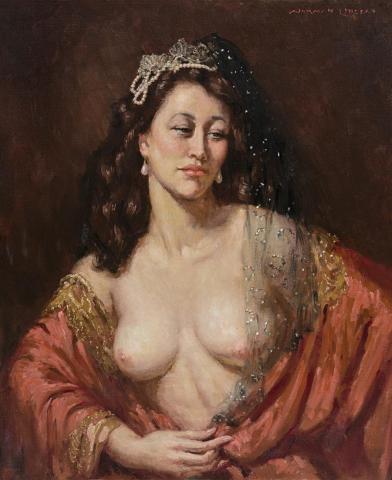RITA, 1941
NORMAN LINDSAY
oil on canvas on board
68.0 x 58.0 cm
signed upper right: Norman Lindsay
Estate of the artist, Springwood, NSW
Private collection, Sydney
The Models of Norman Lindsay, Springwood, Norman Lindsay Gallery and Museum, Faulconbridge (National Trust of Australia), June – August 2012
Bloomfield, L., Norman Lindsay Oil Paintings 1889 – 1969, Odana Editions, Bungendore, 2006, pp. 158–159 (illus.)
Rita was one of Norman Lindsay's favourite models. In addition to her overall beauty, he was enthralled by her bosoms, commenting, 'She had the loveliest breasts I ever painted, and they drove me to despair. No crude combination of colour extracted from the earth can hope to capture the pearly shimmer of light on the youthful feminine breast.'1 In Rita, 1941 Lindsay revels in her beauty, the open garment allowing full focus on her luxurious bosoms. A further tantalising touch is provided by the filmy transparency of her gown, part concealing, part revealing to stimulate the visual and tactile senses. The careful consideration Lindsay gave to her pose can be seen in its development through two pencil studies illustrated in Lin Bloomfield's book on Lindsay's oil paintings.2 From the age of eighteen until her early twenties, Rita sat for Lindsay at his studio in Sydney and then Springwood in the Blue Mountains. She was the model for some of his best paintings, of single and group subjects. They include the demure though stylish Rita of the Eighties, a watercolour of 1940, The Black Hat and Rita of the Nineties both from 1942. Of the subject pictures, Douglas Stewart hailed Reverie, 1939 as 'the best of his oils', while in Crete (both in The University of Melbourne Art Collection) Rita modelled for the main figure as well as most of the others.3
Exotically beautiful, her mother was Spanish and her father Chinese, giving her an olive skin, oval face, long black hair, body languorous, and eyes almond of shape. She also had an inner tranquillity commented on by Lindsay's daughter Jane, who described her as 'supremely decorative'.4 'She managed' Jane added, 'to make a kitchen chair look like a throne'.5 A majestic air permeates all those works in which she appears. In the painting on offer, Lindsay crowns her with a necklace of pearls, an attribute of Venus the Roman goddess of love. As Douglas Stewart said, 'He paints women as if they were goddesses'.6 Lindsay also explores the seeming paradox of voluptuousness and innocence with masterly skill. Women were central to his art and he loved them. They were also his chief weapon against wowserism, casting them in period costume, from history, literary classics, or naked to argue the pleasures of the flesh with an uninhibited bravura. In Rita, Lindsay celebrates feminine beauty in all its fascination and mystery.
1. Lindsay, N., My Mask: For what little I know of the man behind it, an autobiography, Angus and Robertson, Sydney,1970, p. 241
2. Bloomfield, L., Norman Lindsay: Oil Paintings 1889-1969, Odana Editions, Bungendore, 2006, p. 158
3. Stewart, D., Norman Lindsay: A Personal Memoir, Thomas Nelson (Australia) Limited, Melbourne, 1975, p. 175
4. Lindsay, J., Portrait of Pa: Norman Lindsay at Springwood, Angus and Robertson, Sydney, 1973, p. 118
5. Ibid
6. Stewart, D., The Flesh and the Spirit, Angus and Robertson, Sydney, 1948, p. 277
DAVID THOMAS
